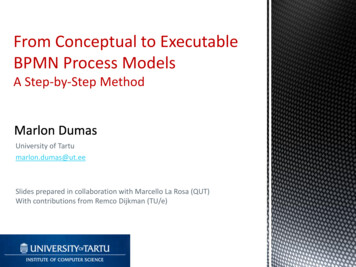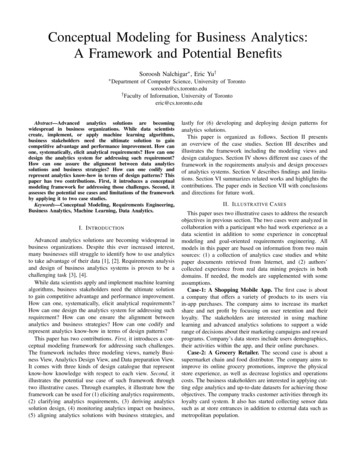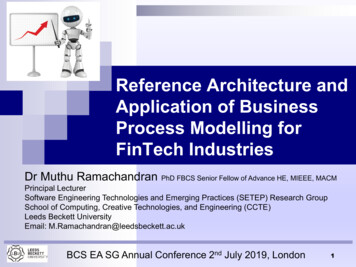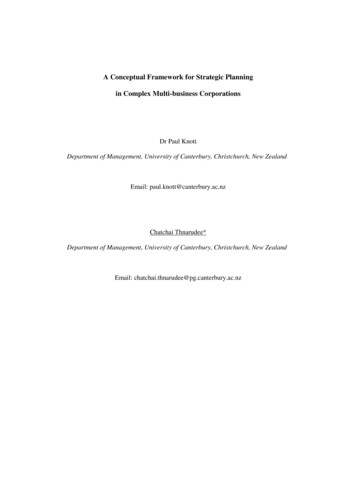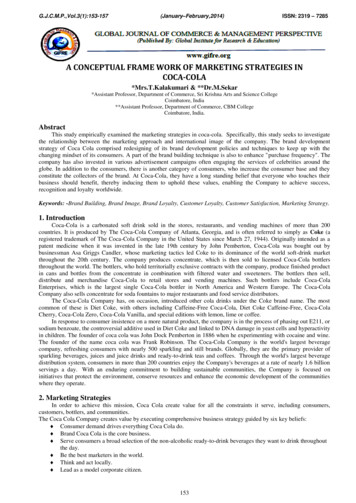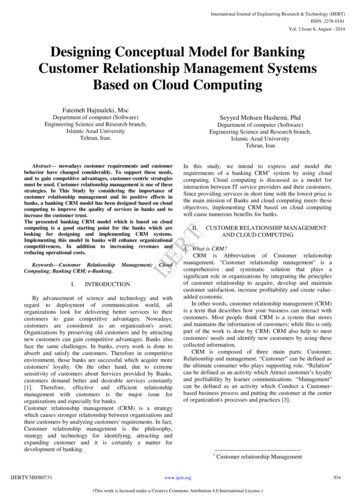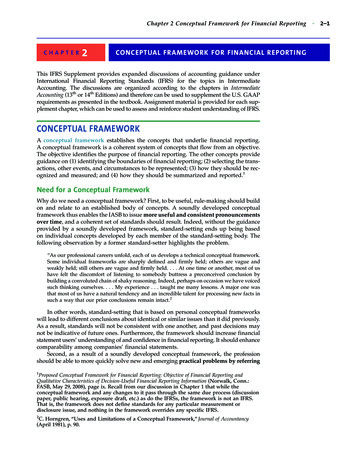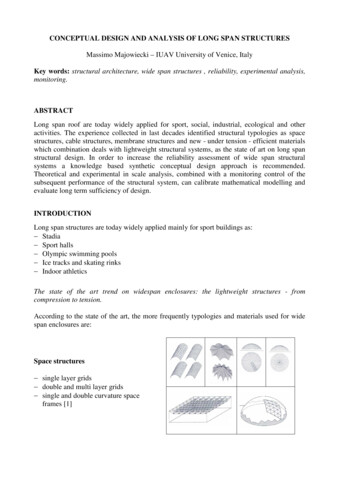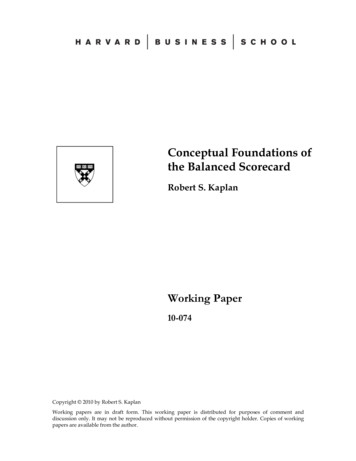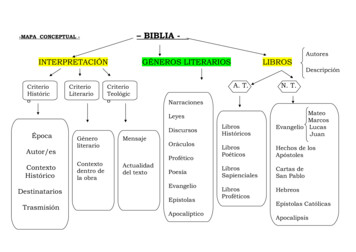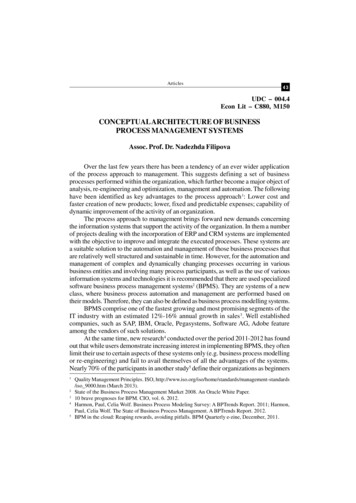
Transcription
Articles43UDC – 004.4Econ Lit – C880, M150CONCEPTUAL ARCHITECTURE OF BUSINESSPROCESS MANAGEMENT SYSTEMSAssoc. Prof. Dr. Nadezhda FilipovaOver the last few years there has been a tendency of an ever wider applicationof the process approach to management. This suggests defining a set of businessprocesses performed within the organization, which further become a major object ofanalysis, re-engineering and optimization, management and automation. The followinghave been identified as key advantages to the process approach 1: Lower cost andfaster creation of new products; lower, fixed and predictable expenses; capability ofdynamic improvement of the activity of an organization.The process approach to management brings forward new demands concerningthe information systems that support the activity of the organization. In them a numberof projects dealing with the incorporation of ERP and CRM systems are implementedwith the objective to improve and integrate the executed processes. These systems area suitable solution to the automation and management of those business processes thatare relatively well structured and sustainable in time. However, for the automation andmanagement of complex and dynamically changing processes occurring in variousbusiness entities and involving many process participants, as well as the use of variousinformation systems and technologies it is recommended that there are used specializedsoftware business process management systems2 (BPMS). They are systems of a newclass, where business process automation and management are performed based ontheir models. Therefore, they can also be defined as business process modelling systems.BPMS comprise one of the fastest growing and most promising segments of theIT industry with an estimated 12%-16% annual growth in sales 3. Well establishedcompanies, such as SAP, IBM, Oracle, Pegasystems, Software AG, Adobe featureamong the vendors of such solutions.At the same time, new research4 conducted over the period 2011-2012 has foundout that while users demonstrate increasing interest in implementing BPMS, they oftenlimit their use to certain aspects of these systems only (e.g. business process modellingor re-engineering) and fail to avail themselves of all the advantages of the systems.Nearly 70% of the participants in another study5 define their organizations as beginners12345Quality Management Principles. ISO, tandards/iso 9000.htm (March 2013).State of the Business Process Management Market 2008. An Oracle White Paper.10 brave prognoses for BPM. CIO, vol. 6. 2012.Harmon, Paul, Celia Wolf. Business Process Modeling Survey: A BPTrends Report. 2011; Harmon,Paul, Celia Wolf. The State of Business Process Management. A BPTrends Report. 2012.BPM in the cloud: Reaping rewards, avoiding pitfalls. BPM Quarterly e-zine, December, 2011.
44IZVESTIA – Journal of University of Economics – Varnain their attempts to adopt and use BPMS. Based on this data we can conclude that themajor barrier to the wider and more efficient use of this class of systems appears tobe the fact that users are not ready to switch to them and do not have adequateknowledge of their features.With reference to this, the aim of the present publication is to define the conceptualarchitecture of the business process management systems so as to offer a generalview of the systems’ capabilities and features, their components and the basicmechanisms of their functioning, while covering the latest tendencies in theirdevelopment. We consider this to be a key prerequisite for the adequate application ofthe process approach in organizations and better realization of its advantages. In ouropinion, to achieve the objective set, it is necessary that the approach applied bebusiness process-oriented as well as focusing on the processes life cycles in BPMS,so that their objectives and capabilities are better revealed, along with their role in theorganization. In this context the following tasks must be carried out: Study the basic characteristics of a business process as an object of processingin BPMS; Study the life cycle of business process management and automation in BPMS,taking into consideration the latest developments in this field; Identify BPMS basic functions by stages of the business processes life cycle; Define the essential subsystems and components pertaining to the conceptualarchitecture of BPMS and the relationships among them.Before we move to the realization of the objectives we set, we need to specifythat the literature in the field, when BPMS are presented, the de facto standard thatis used is the so-called “reference model of WfMC” 6, published in 1995. This modeldefines the basic components and interfaces of the workflow management systems,which are seen today as an earlier stage in the development of BPMS, and one thatdoes not reveal the latest achievements in the field. The reference model also lays thefoundations of a number of standards methods and tools for business processmanagement. It is obvious, however, that the model is not meant for managers andusers of BPMS, but is aimed towards the construction of these tools and towardsstandardization of the technologies they are based on.Documentations on a number of business process management tools also referto some of their architectural aspects. However, a careful study suggests thesereferences are mostly oriented towards the structure of the respective products andtowards particular decisions made while building them, in other words – they concerntechnological architectures. Thus, for instance, from the architecture of MetastormBPM – a product rated “leader” in Gartner’s Magic Quadrant for business processmanagement tools7– we can generally get information on the standards and technologiesthis tool is based on – XML, SOA, WSDL, etc. Product users like designers, developersand clients have been catered for, but little can be learned about the functions that67Hollingsworth, D. Workflow Management Coalition. The Workflow Reference Model.Sinur, J.,J.B. Hill, Magic Quadrant for Business Process Management Suites. Gartner RAS CoreResearch Note G00205212, 18 October, 2010.
Articles45have been assigned to these users8. Similarly, the architecture of Intalio BPMS9 presentsopen code components which make up the system - ApacheTomcat, JBOSS, etc., aswell as the technologies for integrating these components and implementing the userinterface – XForms, Tibco GI, UI-FW. At the same time some functions of the systemhave been identified, but certainly not clarified 10.The conclusion that can be made is that the above mentioned architectures, likeother similar ones, are again mostly aimed at IT specialists – system architects,designers, programmers who build up BPMS and put into practice the projectsconcerning their implementation. Logically, these architectures reflect the viewpointof the developing company and mostly underline innovations and unique solutions thata product provides. We can also notice that architecture usually features as an endresult and no presentation is made of the approach adopted to define it.1. The business process as a basic object of processing in BPMSThe business process is viewed as a means for organizing the company activitythat provides opportunities for continuous improvement. ISO 9000 defines the processas a set of interrelated and interacting activities transforming the input they obtain intoan output that a client finds useful11. Obviously this is a fundamental definition of anunderlying character, describing the essential characteristics and elements of thebusiness process.Other definitions bring to the fore the information-related aspects of a businessprocess as well as the opportunities for its automation. Thus, according to Leymann 12a business process is a sequence of steps taken by various people with the end resultbeing a document, decision, etc.We can generalize that the above mentioned definitions reflect the objectivedirection and the structure of a business process. Some aspects of a business processmanagement and automation are also mentioned However, these definitions do notfocus on how activities are performed in the process, not on the mechanisms of turningthe input into output, yet these questions are essential to the process automation andmanagement, as well as to process modelling and formal representation. Therefore,from the point of view of business process automation we can specify that a businessprocess is a set of activities aimed at achieving a particular goal and performed in acoordinated manner, which transforms the obtained input into output that is useful forthe consumer in accordance with predefined rules and mechanisms.The implementation of a business process requires the participation of humans(employees, clients, etc.) and software systems. Hence, the activities that constitute abusiness process can be divided into three groups13: activities performed by humans8Metastorm BPM architecture. A Metastorm Technical White Paper, Metastorm.An open code product with a number of implementations, incl. in BNP PARIBAS, Deutshe Bank,Santander etc.10http://www.citeck.co.uk/intalio-architecture (March, 2013).11http://www.praxiom.com/iso-definition.htm (March, 2013).12Leymann, F., D. Rоller. Understanding wоrkflоw. The Business Integratоr Jоurnal. Fall, 2001.13Weske, М., Business Process Management: Concepts, Languages, Architectures. Springer, 2007.9
46IZVESTIA – Journal of University of Economics – Varnaonly; system activities that are wholly automated and interactive activities in whichhumans communicate with automated systems.A point should be made that BPMS are mainly designed to support interactiveand systemic activities. It is also possible, by means of interactive activities for thesystem to cover some human-performed activities. For example, receiving a parcel istypically confirmed by the recipient’s signature, but since this is important information,it must be registered in the system by entering the necessary details – date and time ofdelivery, sender’s name, recipient’s name, etc.The management of the sequences in the execution of activities within the businessprocess is implemented on the basis of managing patterns. These are defined on theanalogy of the managing constructs in programming languages. The following can beidentified as examples of essential managing patterns: sequential execution; alternativechoice; repeat execution; parallel execution 14.In order for an organization to function, it needs to support a number of interrelatedprocesses, where often a process output becomes the next process’ input. This callsfor requirements concerning their coordination and synchronization, for the managementof the interaction between them. The terms “orchestration” and “choreography” areoften used in that respect and frequent discussions take place in the specialized literatureconcerning their meaning, the approaches leading to their realization and the connectionbetween them15.Orchestration is associated with the centralized management performed byspecialized software, as well as with the sequence of the activities performed, whichconstitute the business process. Centralized control of this kind resembles theperformance of an orchestra guided by its conductor and this similarity helped reinforcethe term process “orchestration” into the theory on the subject. Orchestration makessure that activities in the process are executed in accordance with the limitations thatare specified in the process model.The interaction within a set of business processes is described by means of their“choreography”. The term shows the lack of a central component that manages andcoordinates the activities performed in different business processes and the interactionamong them is carried out by sending and receiving messages. The processes engagedin interaction must conform to the common rules designed to enable interaction, i.e. acommon choreography.From a pragmatic viewpoint, we need to provide an answer to the question inwhich cases in business process management is it suitable to use orchestration, and inwhich of those choreography. Clearly, if we take into consideration automation,orchestration is easier to implement (no wonder orchestration is being supported innearly all modern tools of business process management). In our opinion, centralized14Gschwind, T., J. Koehler, J. Wong, Applying Patterns during Business Process Modeling. 6thInternational Conference, BPM 2008, Milan, Italy, September 2-4, 2008. Proceedings.15Weske, М. Business Process Management: Concepts, Languages, Architectures. Springer, 2007; Rosen,M. BPM and SOA - Orchestration or Choreography? BPTrends, 2008; Tahamtan, A., J. Eder. Viewdriven inter-organisational workflows. International Journal of Intelligent Information and DatabaseSystems, Vol. 6, No 2/2012.
Articles47control that is inherent to orchestration is suitable for relatively simple processes, thatis, processes of a more static character, fewer participants and a clear, consistentstructure. On the other hand, choreography can be applied to more complex processesof intricate logic, consisting of many steps and stages and involving large numbers ofparticipants. Choreography is the only alternative to inter-organizational (includingB2B) processes, which employ numerous and different automation tools, are subjectto various management standards and policies and aim to achieve different objectives.2. Identifying BPMS functionsEssentially BPMS are designed to support an organization’s business processesby managing their execution and enabling the creation of new automated processes.For this reason as a source point in identifying and systematizing the functions ofBPMS it is appropriate to study the process life cycle in these systems.Having in mind process management and automation through BPMS, the lifecycle of the process can be broken down into 4 basic stages16: design, implementation,usage, evaluation. In order to more precisely define the range and content of thesestages, we have studied the capabilities of several products with process-orientedfeatures, such as Oracle BPM Suite, Metastorm BPM, ARIS Express, Intalio BPMS,Microsoft Dynamics CRM, etc.In the design stage, design or redesign of business processes is performed, basedon needs analysis. The result of the realization of this stage is the development or alterationof the visual model of the business process, which, as we pointed out, is an essentialcharacteristic of BPMS. It is based on the visual model that automation, execution andcontrol are performed on the process in the following stages of its life cycle.Some suites (for example, Intalio BPMS, IBM BPM, Oracle BPM Suite) provideopportunities for using various modelling methods and methodologies, for wideningtheir scope and for pattern import and export. Thus no limitations are necessary forthe use of a particular method or methodology and their advantages can be integrated;besides, conditions are created for the iterative use of models and the creation ofpattern libraries.The business process model contains a set of models of the constituent activitiesthat make up this model, as well as the limitations concerning their execution. Presentedin the business model are the process participants – humans and systems, as well asthe resources needed for the process’ implementation. It is necessary that a capabilitybe provided for the specification of the various patterns for managing the sequence ofactivities that constitute the process, for events and business rules that manage theexecution of the process. Similar capabilities are provided by methods such as BPMN,UML, EPC, which feature among the most widely used ones in BPMS.Based on the model, the process can be verified and trial-tested as early as thefirst stage of its life cycle; its execution can be simulated under particular conditions –for example the number of orders that have to be processed simultaneously, the number16Havey, M. Essential Business Process Modeling. O’Reilly, 2005; Goldstein, T. Process ManagementLifecycle, http://scn.sap.com/docs/DOC-23472 (March, 2013), etc.
48IZVESTIA – Journal of University of Economics – Varnaof employees engaged in the process, etc. Thus not only can the process model betested, but the time for its execution can be measured, the necessary staff and resourcescan be allocated, procedures for processing exceptions defined and the cost of theprocess calculated.The study of the first stage of the business processes life cycle in BPMS provides uswith the well-founded conclusion that it is more appropriate to call this stage “modelling”.In our view this notion corresponds more precisely with the content of this stage, gives abetter idea of the methods and means used in this stage, as well as in the next ones and,generally, better reflects the nature of BPMS. It is important to bear in mind that with usingBPMS a major change takes place in the way software applications are created, emphasizingon the building and control of the business process model.During the execution stage, the process model is transformed into anexecutable definition. The definition of the process must specify precisely andunambiguously, i.e. formally, the process components and logic. Our research hasfound out that for the representation of the definition there are used specializedlanguages such as BPEL и WS-BPEL, XPDL, XAML, XLANG, WSFL. In order toimplement certain more specific capabilities that cannot be represented in the processdefinition, a need may arise for building additional software applications, web servicesand forms of interaction with users.During the execution stage testing and execution of the business process is carriedout as well, including the preparation of the users, so that they are able to make use ofthe process. The basic computer tools that support the business process functions areconfigured – for instance, platforms for the integration of applications such as BizTalkServer, MQSeries, WebSphereMQ, Tibco EAI.During the usage stage the implemented business process is performed andbased on the process definition process copies are created. The process copy is testtrying the model under certain conditions with certain participants and consists ofcopies of its constituent activities. Its creation is initiated by a certain event. Thus, forexample, for every new client’s order a new copy of the “Order processing” processis created and performed. At a certain moment various clients’ orders may be processed,which means that several process copies are processed concurrently.In the process usage stage the BPMS runs applications for automating certainactivities, and coordinates and synchronizes the actions of the people who are involvedin the process. During the management of interactive activities tasks are created andassigned to the users, participating in the business process and individual participantsare promptly informed of any new tasks, deadlines for performing them, etc. Thepossibility is ensured for the input and output of data and for making choices, ifnecessary. Therefore, BPMS can be defined as an integrating platform for businessprocesses execution.It is also necessary to provide a capability for observation and control over theprocess’ copy in real time. For the purpose of using the process model the executionof its copies is visualized. Thus, for example, a manager can, in real time, get an ideaof the stage that sales generated by each broker have reached, monitor each employee’sworkload and which of their assignments they have accomplished (if necessary, tasks
Articles49can be re-assigned), establish the reasons for non-performance of tasks, etc. In someof the products we studied (IBM BPM, MS Dynamics CRM, Oracle BPM Suite,etc.) it is possible to use a control panel and thus monitor key indicators of the processe
BPM – a product rated “leader” in Gartner’s Magic Quadrant for business process management tools7– we can generally get information on the standards and technologies this tool is based on – XML, SOA, WSDL, etc. Product users like designers, developers and clients have been catered for, but little can be learned about the functions that
